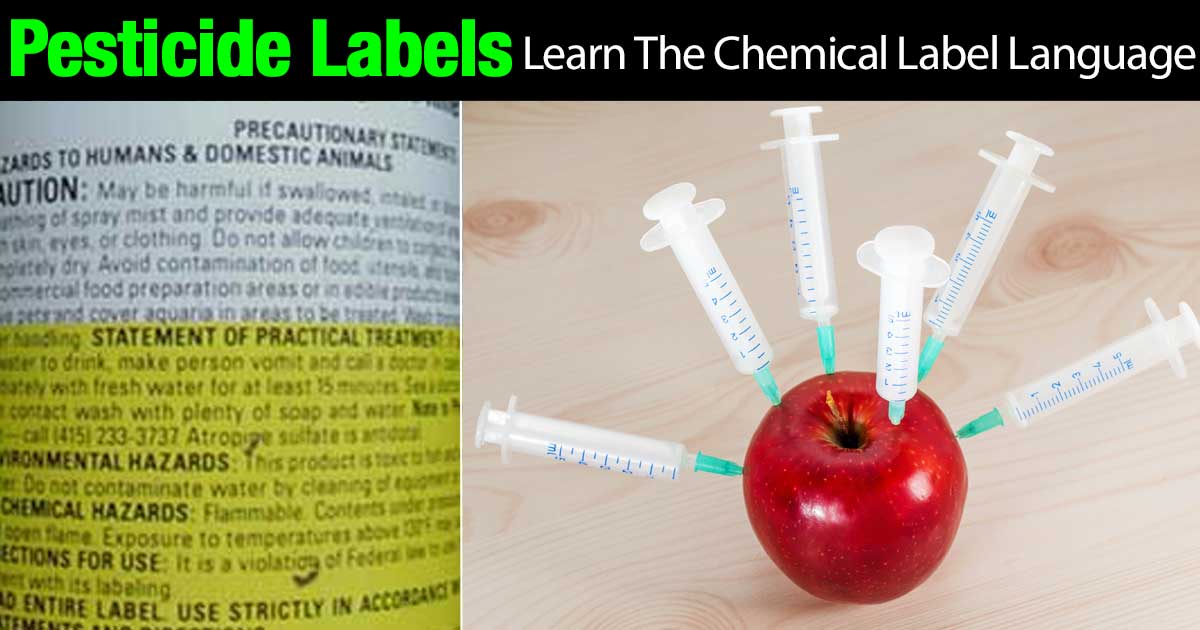The proper use of any pesticide starts with understanding the content of the label.
Homeowners may want to consider an effective non-toxic natural pesticide as an alternative for controlling pests.
The reading and understanding of a pesticide chemical label can be challenging and boring. Reading a chemical label itself can be difficult, throw in the ultra small fine print and reading or a magnifying glass may be needed.

Especially when you are faced with statements like – “attempt to penetrate dense foliage, but avoid overspraying to the point of excessive runoff.” What does that all mean?
In order for users to make sure they have all the information they need to safety apply a pesticide, the EPA – Environmental Protection Agency – in the United States reviews care labeling of all pesticides.
The EPA makes sure the data submitted by the manufacturer is accurate and the chemical does not place humans or the environment at an unreasonable risk level.
The biggest problem on most pesticide labels comes from first reading the label – the language is not user-friendly at all!
If you do not understand the label – get some help from the local garden center, chemical dealer or county extension agent.
Read the Pesticide Label Completely!
The label on the insecticide/pesticide is full of information to protect you, the environment, your plants, and save some money!
Even if you’ve been using a chemical for years it’s good to read and review the label again as plant care labels change frequently.
Labels change as the EPA reviews residue tolerances and the use of chemicals in residential areas and landscapes. Labels may change to increase restrictions from potential widespread use and contact with people.
The responsibility of complying with the pesticide use rest on the applicator. I usually visit the chemical manufacturers website for the most current and up-to-date information and MSDS (Material Safety Data Sheet).
Beware some pesticides carry geographical application restrictions.
Looking In All The Right Places
Every pesticide label must include basic information identifying the product and gives details on how to use, apply, store and dispose of the chemical.
Labels also carry information on:
- Brand name
- Ingredient statement
- EPA registration
- Name and address of the manufacturer
- Net contents
- Self-adhesive labels or label tags
- Formulation
- A short statement detailing product type, like a greenhouse and nursery ornamental miticide/insecticide, specialty herbicide, or fungicide/bactericide.
- Signal words — Caution, Warning, and Danger — telling users how toxic the product is to humans. Pesticides are also flammable and it’s usually advised to not put them near fire or under direct sunlight.
- Precautionary statements
- Minimum personal protective equipment that must be worn while using the pesticide.
- If the product is flammable, explosive, or corrosive
- Check for care symbols and their meaning
This information is very important and plays a major part in treatment or first aid if exposed to poisoning.
Additional sections on the label describe delayed effects of chemical exposure such as possible tumors or reproductive problems, and allergic effects.
Potential environmental hazards are also covered in areas of potential contamination to soil surface or ground water. Other environmental hazards may include toxicity to non-target organisms, such as fish, birds, or beneficial insects like bees when they get near flowers, leaves, stems, roots or any part of the potted plant.
Storage and disposal instructions detail how to store the chemical, deal with any accidental spills, and dispose of empty containers and any excess pesticides. One key statement for storage and disposal or care instructions – “Store in original container only.”
It is also crucial to keep your children and pets away from indoor plants or area of home where you applied pesticides.
Directions for Use
The “Directions for Use” section lists the pests controlled by the chemical, where the chemical can be used and application rates. The label should be followed when applying any chemical.
However, the federal law does give some room to use pesticides in ways not specifically stated in the label.
Here are a few examples for Applicators:
- Use more PPE – personal protective equipment than required by the label.
- Apply a pesticide at any dosage, concentration, or frequency, which is less than the listed label rate.
- Apply a pesticide to a pot plant or site listed on the label which may control a pests not listed on the label.
- Mix fertilizer with a pesticide if the mixture is not specifically prohibited on the label.
- Mixing two or more pesticides together if each dosage is at or below the label rate.
Always keep the pesticide label and all of its content – It may be the most important piece of paper available when you need it.